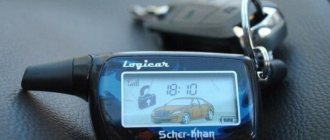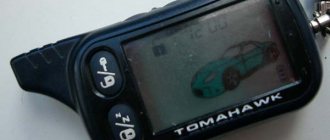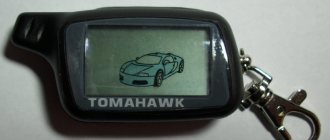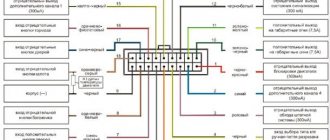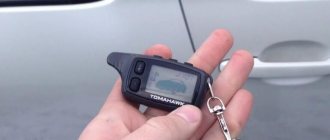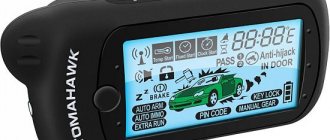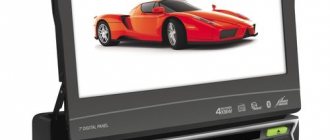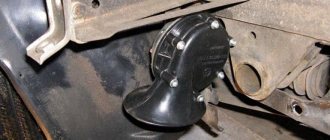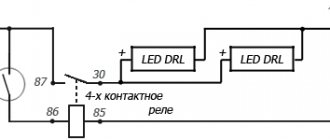01/25/2022 1,751 Alarms
Author: Victor
Do-it-yourself Tomahawk TW 9010 alarm installation begins with disconnecting all energy consumers and batteries. The terminal clamp with a negative signal must be disconnected from the latter to prevent a possible short circuit during the installation process.
[Hide]
Self-installation of Tomahawk TW 9010 alarm system
Before installing this model of security system yourself, it is recommended to check its functionality. Before installation, the Tomahawk 9010 alarm components must be connected to each other in one circuit, which is powered by a 12-volt power source. This will allow you to check the operation of the “alarm” before it is installed directly on the car.
Connection diagram and wire designations
Wiring diagram for connecting the main microprocessor module
When making connections to the main connector of an installed car alarm yourself, the user must be guided by the following data:
| Color | Purpose |
| Black | "Ground" or negative pole. It must be connected directly to the battery or to any standard bolt screwed into the body. It is important that it is fixed as firmly as possible. |
| Blue | Cable for connecting the interior lighting system. It is also possible to connect the contact to the window lift motor. When the protection is activated and disabled, the current on the line should be no more than 300 mA. |
| Red-black | Contact connecting to the ignition switch with output IGN3 |
| Yellow-black | Cable for connecting the starter lock relay |
| Red-yellow | Contact for implementing a second additional channel used to control electrical equipment |
| Black-gray | Output for connecting the tachometer cable or the engine fluid pressure controller in the lubrication system |
| Red-blue | Positive input for connecting door and hood sensors |
| White-orange | Negative output for door lock controllers |
| Violet | Contact for implementing the “Anti-robbery” option. The function should be turned on when a negative signal appears on the line. |
| Black-green | Power cable for side optics or light signaling. The circuit must be protected by a fuse device rated at 7.5 amps. |
| Yellow-green | A similar contact for connecting external lighting devices |
| Black and white | Programmable additional powertrain locking |
| Grey | Contact for connecting siren power supply |
| Blue-yellow | Cable for implementing a third additional channel or two-stage opening of door locks |
| Black and yellow | Contact for remote opening of the tailgate |
| Purple-orange | Wire for connecting to the parking brake lever sensor. If the car is equipped with a manual transmission, then the contact is connected to the negative signal of the handbrake. If you have an automatic transmission, the connection is made to the brake light circuit. |
| Black-blue and gray-orange | Contacts for connecting door and hood controller inputs |
One of the main nuances that must be taken into account when installing and connecting yourself is connecting the contacts on the autostart connector:
| Color | Purpose |
| Yellow-black | Contact for connection to the starter mechanism. This element must be connected to the output on the ignition switch, where a 12-volt voltage is generated when the key is turned to the “Starter” position. Used to start the power unit, it is necessary to make a connection in the area after the blocking relay. |
| Blue | Output pulse for auxiliary devices and equipment. It must be connected to the ignition switch contact, which generates a 12-volt voltage when the key is in the “ACC” mode. |
| Red (thin) | System power cable. Must be connected directly to the positive terminal of the battery. The electrical circuit must be protected by a 10 amp fuse device. |
| Red (thick) | Power supply contact for remote start power lines. It also needs to be connected directly to the battery. But this circuit must have a 40 amp fuse installed. |
| Yellow | Contact element IGN1. It must be connected to the ignition switch, to the output where a 12-volt voltage is generated when the key is switched to “ACC” mode. It is important that the load on the line does not disappear in the “Starter” position. |
| Green | Contact element IGN2. Must be connected to the contact on the lock, where voltage appears in the "ACC" mode and disappears in the "Starter" |
Selecting the location of the main blocks
Correctly determining the installation location of the component elements is necessary taking into account the design features of the car:
- The control module of the Tomahawk 9010 automotive system is installed in the vehicle interior, in the most hidden place and protected from external influences. It should be placed with the connector facing down to prevent liquid drops from running down the wires and moisture from getting inside. It is possible to install the device behind the instrument cluster; it must first be dismantled and turned off.
- In accordance with the Tomahawk 9010 operating manual, the siren is installed under the hood of the car. The wires from the device must be routed to the control unit in the passenger compartment; electrical circuits must not be accessible from under the bottom of the car. The siren should be placed in a hidden place, not exposed to elevated temperatures. If an autonomous device is used, then it is necessary to ensure free access to its well.
- Door triggers must be embedded in places protected from moisture. When these body parts are locked, the limit switches should not be accessible. Wiring from the devices is routed to the microprocessor.
- The shock and sensitivity controller is installed inside the car. Ideally, its installation should be done in the central part of the body. The device is fixed on a flat surface using glue or self-tapping screws.
- All high current lines must be protected with safety devices of a certain rating. Available in the form of a wire for connecting marker optics, power supply for alarm systems, and central locking.
Photos of diagrams and detailed descriptions
Diagram of the security system control unit in pictures:
Download the official instructions.
Use the following data to independently connect the main connector of the control unit.
- Connect the black wire to the negative terminal of the battery.
- In blue, contact the interior lighting system.
- Connect the ignition switch and the IGN3 output in red and black.
- Connect the yellow-black wire to the starter lock relay.
- Red-yellow align with the second electrical equipment control channel.
- Black and gray - with tachometer.
- Red-blue (positive input) - with hood and door sensors.
- White-orange (negative output) - with door locks.
- Violet - with the “Anti-robbery” contact.
- Black and green contact the power supply dimensions.
- Yellow-green connect to the power supply to external lighting devices.
- Black and white wire - with additional engine blocking contact.
- Gray — siren power supply.
- Blue-yellow - with the contact of the third additional channel.
- Use the black-yellow wire to connect the contact for remotely opening the trunk door.
- Purple-orange - with parking brake limit switch.
- Connect the black-blue and gray-orange wires to the contacts of the door and hood limit switch inputs.
How to connect an alarm without auto start
The absence of an automatic engine start function greatly simplifies the installation procedure of the anti-theft system. To connect, the user will need contact elements for the door position as well as the ignition switch.
Preparing the device
To prepare the system, perform the following steps:
- An additional relay and a safety device are installed in the ignition circuit.
- A microprocessor alarm control module is installed.
- The shock controller and transceiver are being installed.
- Pulses from the ignition switch and door positions are connected to the Tomahawk 9010 control module. The light signaling power lines are connected in parallel to the siren.
Working with ignition
If an ignition system blocking relay is used, then when connecting you need to use the electrical diagram:
Engine starting circuit using a blocking relay
Low current circuits and main connector
The installation of low-current power lines of the Tomahawk 9010 anti-theft system is carried out as follows:
- The power in the car turns off; to do this, you need to de-energize the battery.
- The main elements are connected to the microprocessor device. Available in the form of a transceiver with an antenna adapter, an LED, and a sensitivity controller.
- The contact elements of the hood and door sensors are connected to the main block of the control unit.
- The electrical circuits of the engine fluid temperature and pressure controller are connected to the instrument cluster. The contacts of the corresponding sensors are used for connection.
- After the connection is completed, all circuits are checked using the tester.
basic settings
For the temperature sensor, set threshold values at which it will send signals to the remote control or automatically adjust the autorun operation.
Adjust the sensitivity of the shock sensor based on its response. To do this, lightly knock on the car body to provoke it into operation. Apply blows serially, giving a noticeable push.
The system allows you to configure the following parameters:
- remote engine start;
- daily autostart of the car;
- turbo timer for turbine cooling;
- automatic engine start based on temperature and time;
- calling the vehicle owner.
All settings of the anti-theft system are installed, and it has been working properly for a long time. But it happens that the sp error is displayed on the key fob (on VAZ 2112 coupe, Audi, Ford, etc.). This is an autorun glitch. Something happens in the car that violates the autostart conditions. In this case, check whether you fulfill the autostart conditions correctly and whether this function is programmed correctly on the remote control. The second reason may be a breakdown of the security system control unit. Contact the service src=»https://daciaclubmd.ru/wp-content/uploads/2019/03/poread-5.jpg» class=»aligncenter» width=»600″ height=»375″[/img]
How to program important options
Before using the anti-theft system, you must install a working battery in the communicator. The power supply is installed in a special compartment hidden behind the back cover. When installing, polarity must be taken into account. After removing the old battery and installing a new one, the user must press the button on the remote control with the open trunk indicator.
Key fob programming
Using all the functions of the Tomahawk 9010 car alarm is possible only after linking the communicator to the control unit.
The procedure for programming the key fob is as follows:
- The key is inserted into the ignition and turned to activate the ACC position. The car engine does not start.
- The button to enter the emergency maintenance mode “Override” is pressed and held for several seconds. You can release the key after the alarm siren sounds four beeps.
- Then the buttons on the key fob are pressed and held in the form of an open trunk and a crossed out speaker. A siren will sound to confirm the binding. If no programming action is taken within 6 seconds, the alarm will exit the menu.
Video
User Olzhas Zhailaubay showed in his video how the automatic engine start option works on a car with a Tomahawk 9010 alarm system installed.
This is my second experience installing an alarm in a car, you can read about the first here Self-installation of a Leopard LS50/10 PLUS alarm
When I bought the car, it already had a simple (open-close) non-working alarm system, which significantly simplified the installation process (there was no need to install drives, and almost all the main connection points were already installed in the place I needed). It’s strange that alarm installers also charge an additional fee for dismantling the old security system! =)
First of all, we decide on the installation locations of the security system elements:
— The electronic alarm control unit is installed inside the vehicle. — To obtain maximum range, the transmitting and receiving “RF” antenna of the system unit must be positioned as high as possible, not in contact with metal objects or electrical wiring harnesses. — The siren is installed in the engine compartment, in an inaccessible place. If you are using a stand-alone siren, provide access to the service key hole. The siren should be installed with the horn facing down, this will prevent moisture from entering. It is better to plan the wire connections inside the cabin for less oxidation. — All high-current circuits (power supply, side lights, central locking, etc.) must be protected by fuses of the appropriate rating. — The hood and trunk triggers cut into places protected from moisture that are inaccessible when the hood and trunk are closed. Triggers need to be lubricated periodically to prevent seizing and corrosion. — The shock sensor is installed in the cabin, the center of the car can be considered ideal, it is attached to the metal of the body with self-tapping screws or glued (but in experience, the sensor works better on plastic, which will be discussed below). — Contacts in places where ignition, starter, etc. circuits are broken. It is recommended to solder.
Then we cut or leave a jumper on the alarm control unit (closed - automatic transmission, open - mechanical), remove the negative terminal from the battery and connect to the car wiring, according to the CONNECTION DIAGRAMS.
In comparison with “budget” security systems, Tomahawk brand equipment has proven itself well. Now in 2015, many Tomahawk Car Alarm systems have been discontinued. The following families of alarms are still produced: Z, X, S, TZ 7010 and some others. On sale, however, you can find Tomahawk tw 9010 or tz 9030 alarm systems. The second of them is more modern, all functions in it are programmable, and that is why it is better to give preference to a simpler model. At least on the Tomahawk tw 9010 signaling, it is impossible to “accidentally” reprogram the purpose of the “ACC” terminal connected to the power wiring.
Standard connection tw 9010
The Tomahawk equipment manufacturer suggests connecting the alarm as follows:
Reviews tell us that the standard connection option in VAZ cars is easy to implement. You don’t have to connect the hood switch, the Anti-Hijack button, and the “blue-red” wire coming from the connector is definitely not needed. You can connect a blocking relay connected to the “black-yellow” cable if autostart is needed. In general, connecting the Tomahawk tw 9010 signaling system is a pleasure if we are talking about a VAZ-2110.
There are two connectors under the dashboard of the VAZ 10s. They are painted white and red. When making T-shaped connections, the following wires are pulled from the connectors:
- Tachometer cord connected to pin “3” of the white connector;
- Parking brake sensor wire (white connector);
- Two cords from the turn signal lamps (terminals 5 and 6 of the red connector).
Peculiarities
To begin with, it will be useful for you to learn about the features of the Tomahawk alarm, so let's start with a description of the main characteristics. The features below are described using the Tomahawk X5 car alarm as an example.
To understand how the circuit works as a whole, we first suggest finding out what elements the device consists of:
- main module, which is a block;
- key fob (the X5 model comes with a key fob with an LCD display);
- another key fob, as a backup, is usually not equipped with a display;
- shock sensor, works in one of several modes;
- The Tomahawk X5 alarm model is also equipped with an antenna through which data is received and transmitted;
- temperature sensor;
- a fuse that, if the car is opened, will block the engine;
- wires that allow connection according to the diagram;
- LED light bulb installed in the car interior;
- user manual.
The key fob is designed to control car alarms.
In the case of the Tomahawk X5 model, the control option is as follows:
- the protective mode is triggered after you press the key fob button;
- if necessary, you can configure the key fob so that the security mode is turned on at a certain time (you can correctly determine the functions and configure them using the operating instructions).
Wiring diagram for the Tomahawk anti-theft system
As for functionality, Tomahawk alarms generally have the same functions as other standard devices.
- Anti-scanner and anti-grabber. Their purpose is to protect the device from digital signal interception. That is, if an attacker tries to intercept the button signal over a wireless network, he will encounter additional protection.
- Another useful feature is Mhz autostart. Autostart on the Tomahawk X5 model is equipped with a timer and interior temperature. If the car is equipped with auto start, then the car starts according to the settings that need to be determined in advance.
- If the driver forgets to press the key fob button, the system is activated automatically.
- Turbo timer. If the car engine is running, then the turbo timer will allow you to set the car alarm with the engine running, while the doors are closed.
- Motor blocking. Even if intruders are able to turn off the shock sensor and open the doors, the engine will be blocked, and the Tomahawk X5 alarm key fob will receive a signal about a break-in.
- The alarm system is also equipped with a built-in central lock.
- The Tomahawk X5 model is equipped with Valet mode. This mode allows you to disable protective systems. This function is relevant if you are sending your car for repairs.
- Silent protection option. If an attacker tries to disable the protection, the system will not make sounds. Even if a criminal opens the doors, the alarm will remain silent. The signal will be sent exclusively to the key fob, at which time the attackers will not even realize that the owner of the car knows everything.
- Timer, clock and alarm clock. In general, these options are not particularly relevant for alarms, but the developers of the Tomahawk X5 decided to add them.
- Don’t worry about the fact that the key fob is universal and opens all cars with such a security system. Each Tomahawk X5 alarm has a specific PIN code that allows you to control the security to disable it.
- If necessary, it is possible to connect your steering horn to a siren, which works when an attempt is made to break into the car.
- If the safe driving option is enabled, the system will automatically lock the car doors from the start of driving. The doors will only be unlocked after the vehicle has stopped. The door lock option is very useful, since no one is immune from accidents, especially if you have children. The doors will be locked from the inside and the child will not be able to open them (video author - Evgeniy Ignatov).
Connection without autostart
Automatic start is needed to implement auto-warming of the engine. We will assume that the owner does not need the last option. Installation and installation of car alarms, regardless of their brand, in this case is simplified. Now we will look at how to prepare standard connectors before installing the Tomahawk alarm system. Read carefully.
Standard modules of VAZ-2110, preparation
The dashboard housing hides two electrical connectors. You will need 4 wires:
These figures were presented in text form earlier. Now let’s note that the car alarm must receive information about whether the doors are open. Therefore, you will need 4 more contacts:
On the contrary, it would be advisable to solder power cords. This is done with the “green-yellow” and “green-black” wires going from the Tomahawk alarm module to the turn signals.
Installing car alarms is not such a difficult task. But you need to know where and what is in the car. Standard connectors look like this:
Here the “blue” and “blue-white” cords are connected to the turn signals, the “yellow” cord is connected to the tachometer. You will find four “important” wires coming from the BSK module connector right away. By the way, they are not connected to the Tomahawk alarm directly, but through blocking diodes. The anodes of 4 diodes are twisted and connected to the “blue-black” cable.
Any car alarm is connected to the door switches not through ordinary diodes, but through Schottky diodes. For example, parts marked 1N4001, etc. are suitable.
If we talk about connecting the central locking, the well-known diagram is recommended by the car alarm manufacturer itself:
But reading the reviews, you can understand that everything looks simpler on the VAZ-2110. To control the central locking, a zero potential is applied to the “white” or “brown” wire:
This means that these cables can be connected to the wires coming from the 6-pin connector of the Tomahawk tw 9010:
Having implemented the simplified version, it will be undesirable to give conflicting commands: by moving the “dog” down, you cannot take the key fob and press the UNLOCK button (open).
What to do with the ignition
A blocking relay is supplied with the Tomahawk equipment. Connect it according to the diagram:
Manufacturers do not provide markings for the socket cords. But the cable connected from the lock side can be determined by the operation of the relay:
“Minus 12 Volts” is connected to the brown cord, and positive voltage is applied in turn to the power cables.
The car alarm in question is connected to the relay with one cable (“black and yellow” from the main connector). But the installation is carried out when all connections have already been made.
Here the power cord comes to the third contact of the terminal block and is broken. And the fourth contact must be connected to the “yellow” cable, to which the car alarm is connected via a standard connector.
All Tomahawk equipment has the property that if the main unit fails, the relay will still conduct current. But if you turn it off, that is, remove it from the socket, it will be impossible to start the engine. So, when performing installation, take care to securely fasten the relay socket. The latter is true not only for Tomahawk brand systems, but also for other blocking equipment.
Low current circuits and main connector
The main unit of the Tomahawk security system is equipped with several connectors:
What to do with 6-pin terminal blocks is discussed above. And to subsequently configure the system, connect the antenna unit, the Override button and the LED. Now let's talk about connecting the main terminal block.
The jumper installed on the main unit is cut to block autostart when the handbrake is on. If autorun is not used, leave the jumper. The wires of the main connector are connected as follows:
Blue crosses mark optional connections. For example, you are not using the hood sensor, but the Tomahawk system thinks it is closed.
When performing installation, disconnect the standard battery. After switching on, the alarm is in the “Open” mode.
Instructions for use
How to properly install and configure a protective system with temperature and shock sensors? Instructions and connection diagram are given below.
How to connect?
The connection process consists of several stages.
The instructions are:
- First, the siren is installed in the engine compartment. To do this, you need to take into account that their installation is carried out in a place where there is no moisture at high temperatures. Sirens should not interfere with vehicle repairs, and their horn should always be positioned downwards.
- Then the hood end is mounted. You need to use any hole in the engine compartment that is suitable for this purpose. The limit switches should not rest against anything; their contact should be as reliable as possible.
- Now the temperature sensor is being installed. It is better to screw this sensor to the engine, so you can get more reliable information about the temperature state of the motors. The black wires of the sensors are always installed to ground, and their white (or light) wires should be connected to the orange wire from the limit switch mounted on the hood. It is better to solder such joints and install special heat shrinks on top. Next, the wiring from the limit switch and siren should be connected to the wiring of your car, so you will need to bring them into the cabin.
- The next step will be to install the antenna. This element should be installed away from metal parts and wiring. Often, antennas are installed in the area of the windshield, for example, in the upper or lower corner. Wiring can be laid under the casing.
- Now you need to install an LED lamp, which will indicate that the system is working. It can also be installed next to the antenna; in some models, the antenna comes with a lamp in the same housing.
- Next, you need to connect all the wires and connectors to the central unit. This is done in accordance with the diagram that comes with the security system.
- Find a location for the shock sensor. It is better to secure the shock sensor with a zip tie or double-sided tape. You can also screw the shock sensor if there is a corresponding hole. It is advisable to choose a convenient location, since you will subsequently configure the shock sensor. To avoid mistakes during installation, watch the video (the author of the video is avtozvuk).
Now let's move on to the malfunctions characteristic of such car alarms.
- If the system does not respond to pressing the buttons on the key fob, then, as a rule, the fault lies in the fact that the battery in the key fob is dead or the device needs to be programmed. Also, your vehicle may currently be in the interference zone.
- A common problem with Tomahawk is that the system does not turn on the fuel pump. In this case, you will have to contact an electrician or the person who installed the system. There may be connection problems.
- If the malfunction is that the system does not close all doors, most likely you need to carry out a thorough diagnosis of the central locking drive. If only one door does not close, then a certain wiring may be broken or broken.
- If the key fob from the system works randomly, in our words “buggy”, then you also need to check the battery. If it is normal, then you can try to program the device again.
- The system may flash 10 times; this is a Tomahawk-specific problem. In this case, you need to diagnose the communication module loop.
How to program important options
To program the Tomahawk tw-9010 block you will need:
- At least one key fob perceived by the system;
- Functional Override button;
- Before performing any operations, disarm the vehicle.
Take the main key fob, press the “Lock” button. If the screen displays “locked”, press the key again.
A set of software-defined options is given in any manual for the Tomahawk signaling system. The key fobs are equipped with four buttons, and the value is set by pressing one:
Let's program the system for control “by tachometer”:
- When the alarm is disarmed and the doors are closed, turn on the ignition without starting the engine;
- Press Override 6 times;
- Turn off the ignition (a chirp signal will sound).
Now, press Override 4 times in a row. Then, select “value 3” by taking the key fob and pressing the “Trunk” button.
You won't need keychains anymore. Follow steps 1-3 by pressing Override 9 times. If an LED is connected, wait until it turns on. Start the engine, and at 1000-1500 rpm, press and hold Override. A single “chirp” will sound, indicating that the Tomahawk system has been “successfully trained.” If you hear 4 “chirps”, do the training again.
If everything is done without errors, the main key fob will correctly display the engine operating mode.
